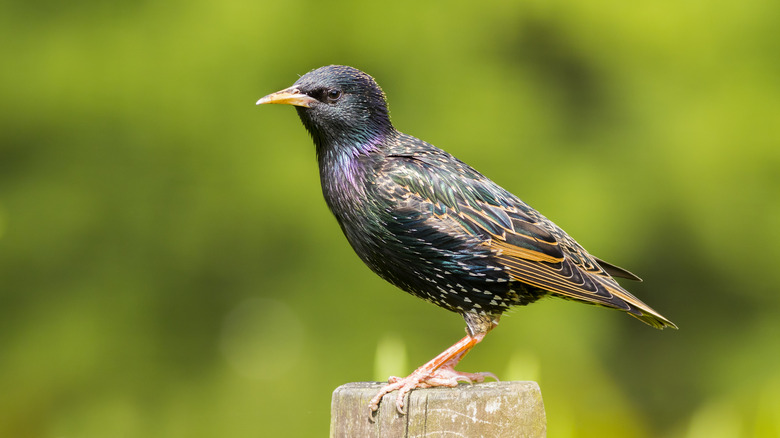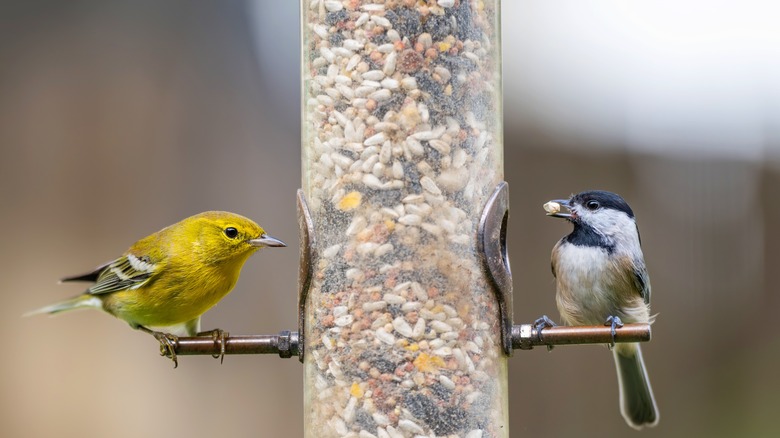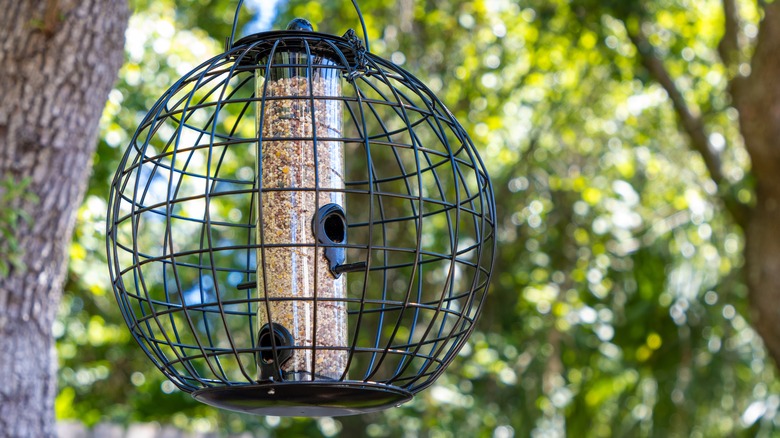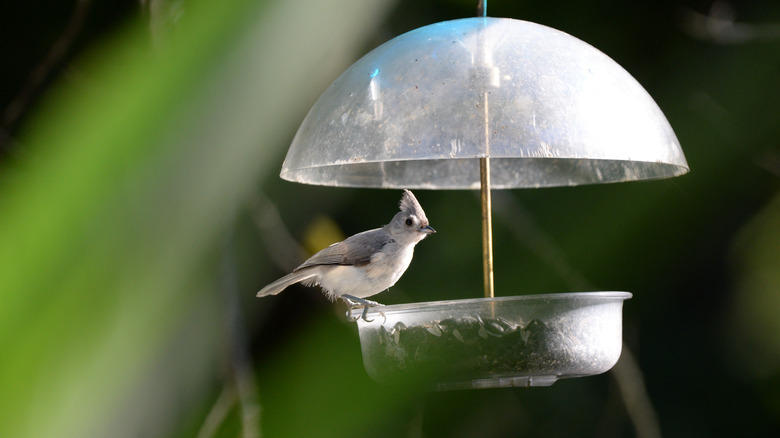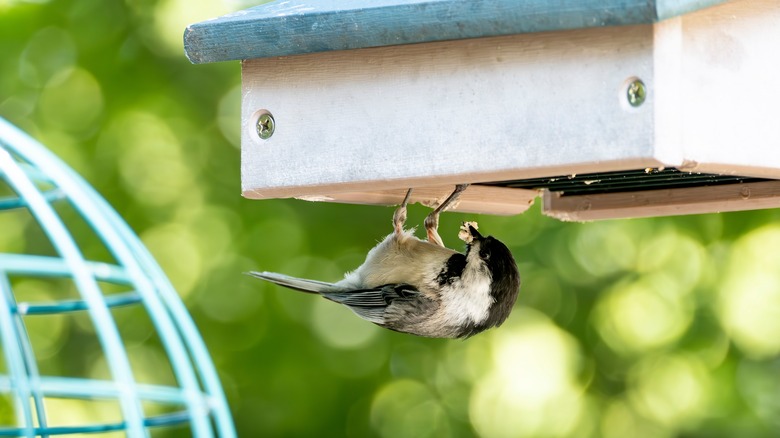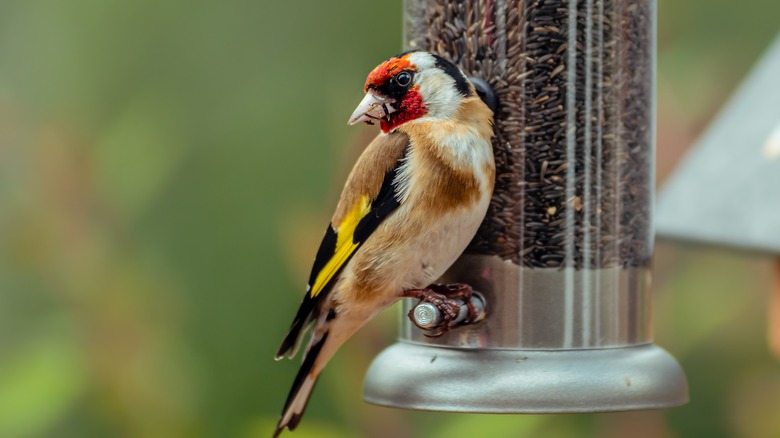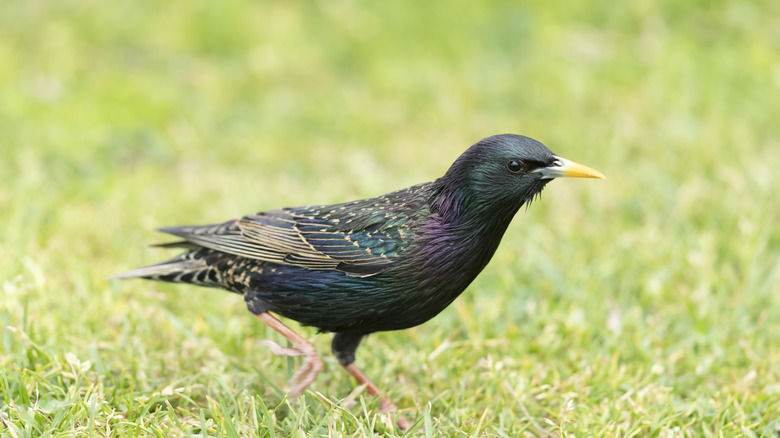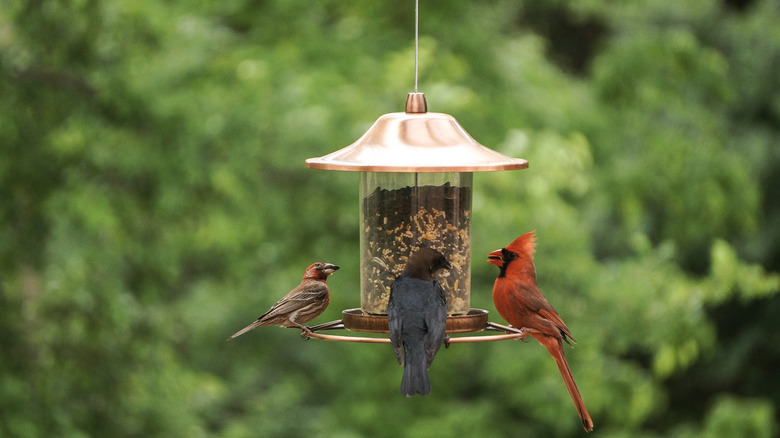How To Keep Your Birdfeeders Starling-Free For Good
We may receive a commission on purchases made from links.
Most birds who visit feeders in your yard can coexist peacefully, taking turns at the feeder and making room for others. And then other birds are, well — just kind of jerks. Bullies. The starling can be one of those birds, wreaking havoc at your feeders and turning your normally soothing birdwatching time into the equivalent of watching a half-dozen hyper, noisy toddlers at play.
Because of this, starlings are a bird breed you don't want in your backyard. They're loud and generally hang around in large flocks. So, you rarely just have one starling if they're visiting your yard; you have their friends and family, too. They tend to be aggressive toward other birds, chasing them away from the feeders so they can hog all the food. And they can be this brazen mainly because they have few predators in North America. Luckily, there are a few things you can do to keep starlings away from your feeders so your favorite songbirds can eat in peace again.
Look for tube feeders with short perches
Tube feeders are great for providing space for a variety of birds to eat, but starlings can be disruptive dinner guests. Not only do they chase other birds away, but they usually end up flinging the seed all over the place, leaving much of it on the ground. This results in a lot of wasted seed, which can also attract other pests such as mice. It also means you'll be buying birdseed more often to try to keep up with the demand.
The solution here is to alter or swap your tube feeder. Starlings are fairly large birds, and they are less able to perch on small perches. You can look for tube feeders that have short perches or alter your existing perches by cutting them shorter. Smaller birds can easily perch on the feeder to eat, but starlings may be thwarted.
Consider feeders with cages to keep food away from starlings
Caged feeders are another way to use the starlings' size against them. These feeders are suitable for finches and sparrows, but larger birds like starlings will be kept away from the feeding ports. This also enables those smaller songbirds to eat in peace, protected from the starlings by the outer cage. The only drawback is that these feeders can also keep out larger songbirds, such as bluejays.
You can either purchase a caged feeder, like the Mosloly Caged Bird Feeder, or you can alter an existing tube or platform feeder by surrounding it in wire hardware cloth. Look for hardware cloth that has openings 2 inches wide; this will allow smaller birds to get in but keep large birds like starlings out. Make the cage large enough so the feeder is located several inches inside the cage. This will ensure that even if larger birds are able to cling to the cage, they can't reach in far enough to get to the food.
Get a domed feeder to keep starlings out
Starlings are surprisingly timid about going under any type of cover, even for food. You can use this hesitance to your advantage by installing domed feeders. Songbirds mostly don't mind the cover, but it'll be enough of a deterrent to send starlings on their way. The most effective types of feeders to use with domes are platform or dish feeders, as seen in the photo above, or suet feeders.
You can buy domed feeders nearly anywhere you buy birdfeeders. You can also use a squirrel baffle above an existing one to keep the starlings away. The great thing about this is that it won't require you to buy an entirely new one, and baffles are much more inexpensive than good-quality birdfeeders. As an added bonus, domed feeders can protect the buffet you've lovingly provided from the weather, so seed doesn't get wet or moldy.
Switch to upside-down suet feeders
Suet feeders attract a wide range of birds, including chickadees and woodpeckers. Suet is usually offered during cooler weather, and it's usually made of rendered fat with seeds, dried fruits, and other grains mixed into it. This high-calorie treat is irresistible to many birds and can keep birds at your feeders longer. Unfortunately, starlings also enjoy suet, often hogging the feeder and devouring a suet cake in no time.
Most suet feeders are wire cages that hang from a branch or hook. These allow starlings to hold on while they're eating, which makes it easy for them to eat as much suet as they want. But, as noted above, large birds such as starlings aren't good at clinging to things long enough to eat, and this is even more true when it comes to clinging upside-down. An upside-down suet feeder is a great option for birds such as nuthatches and woodpeckers (who also love suet), but starlings aren't strong enough to use them. These feeders usually look like a box with a wire or caged bottom. This keeps the suet cake protected from all sides except the bottom, enabling songbirds to get to it, but making it difficult for starlings.
Add predominantly hard-shelled feed
Like any creature, starlings have food they love and food they avoid in hopes of finding something they like better. They love black oil sunflower seed, millet, cracked corn, and shelled peanuts. Luckily, you can fill your feeders with food they don't like, but other birds absolutely love. The key here is understanding a little more about how starlings eat.
They have softer bills than many other birds, so you can use that to your advantage when selecting seed. Striped sunflower seeds have harder shells than the more common black oil sunflower seeds seen in birdseed mixes. Cardinals, finches, and sparrows can still easily eat these seeds, but starlings are out of luck. Another option is peanuts in the shell. Jays and woodpeckers love peanuts in the shell, but the shell is too strong for starlings. By offering these two items in particular, you'll keep most of the desirable songbirds in your yard happy while effectively discouraging starlings.
Catch seeds from hanging feeders
As you've noticed, many of these tips are about making your feeders less attractive to starlings or making it more difficult for them. It doesn't make much sense to put up the right kind of feeder, but then continue to offer a free buffet beneath it as other birds knock seeds onto the ground. Starlings will happily eat from the ground, so if you want to keep them away, you'll also need to pay attention to the fact that birds of any kind are often messy eaters.
The best solution here is to catch seeds from hanging feeders so starlings won't have easy access to the ones that have fallen. This can be as simple as placing a garbage can beneath hanging feeders. Not only will this keep the ground free of seeds that might attract starlings, but it'll save you money on bird food, since less of it will go to waste. Cover the garbage can at the end of the day to keep rodents away, then use the fallen seed to fill your feeder.
Take a break from feeding the birds
Sometimes, you'll still have a starling problem at your feeders after trying these methods. Or maybe changing your feeders and the type of food you offer isn't feasible. In either of these cases, the best option might be to take your feeders down and take a break from feeding the birds.
If you remove the feeders from your yard, the starlings will move on to the next available buffet, leaving your yard alone. After a few weeks, you can put them back up. The downside of this method is that you also won't be providing food for the cardinals, finches, nuthatches, and chickadees you enjoy seeing in your yard. But the songbirds will eventually find your feeders again, and they'll be able to enjoy the buffet you supply for them. In the meantime, the starlings will lose interest, and once they find a more hospitable place, they're less likely to mob your feeders again.
